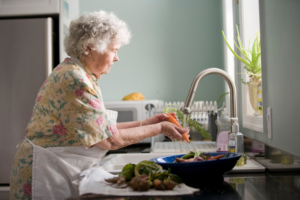Sheltering for Seniors in an Emergency
Have you ever thought about how our beloved seniors might need some extra TLC during emergencies? Or maybe you are a senior creating a plan for your own needs. It’s important to prepare and plan ahead to keep you and our loved ones safe and secure.
This article is going to focus on:
- being prepared to shelter at home,
- being prepared to evacuate,
- general guidelines to keep seniors’ homes safe from day-to-day,
- and 72 hour kits for seniors
Might I also add, if you have any questions, concerns, or thoughts, our team at Briden Solutions would be happy to help you in any way we can.
Ideas to Consider In Your Emergency Plan
- Medical conditions and medications: Be aware of seniors’ health needs in emergencies. Organize meds and medical documents. It’s not always feasible to store meds in your grab and go kit, however I do recommend keeping and updating a list of current medications. Another tip is to keep medications in a primary location for quick access.
- Cognitive impairments: Memory loss and other challenges pose some real hurdles during emergencies for seniors. We need to be guiding lights and accommodate quirks during these tough times. Further down the article there is a list of suggestions on how to handle a situation to alleviate the stress for everyone involved.
- Medical Equipment and Devices: Seniors may use hearing aids, glasses, or other assistive devices that they need to have readily available in an emergency situation. Those with medical conditions may also depend on equipment like oxygen concentrators, CPAP machines, or dialysis equipment, which require a stable power supply.
- Other: Dietary constraints, temperature sensitivities, and mental health conditions may need to be factored into the plan.
Emergency Plan for Seniors: Sheltering at Home
Assess the risks! Sit down and figure out what could go wrong. Example: what if homecare is unavailable to arrive for 24 hours? A little home safety evaluation goes a long way!
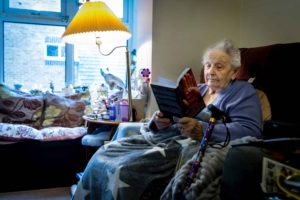 When conducting a safety evaluation for seniors’ homes, it’s important to be on the lookout for potential risks. Here are some common areas to consider within the home:
When conducting a safety evaluation for seniors’ homes, it’s important to be on the lookout for potential risks. Here are some common areas to consider within the home:
- Trip Hazards: Look for loose rugs or carpets, cluttered walkways, electrical cords across walkways, or uneven flooring that may pose a tripping risk.
- Stair Safety: Check the condition of handrails and ensure they are sturdy and well-maintained. Look for any loose steps, worn-out carpeting, or inadequate lighting on stairs. If a lift is installed, ensure that backup power/batteries are available.
- Bathroom Safety: Assess grab bars and handrails in the bathroom, ensuring they are properly installed and secure. Look for slip hazards like wet floors, loose bath mats, or inadequate lighting.
- Kitchen Safety: Identify potential fire hazards such as unattended cooking appliances, overloaded outlets, or flammable materials stored improperly. Check for sharp objects or heavy items that may cause injury if improperly stored.
- Electricity and Appliances: Ensure that electrical outlets and switches are in good condition and not overloaded. Look for faulty or frayed electrical cords and potential fire hazards near heat sources or appliances.
More Home-Care Tips:
- Home Security: Evaluate the quality of locks on doors and windows. Install smoke detectors and carbon monoxide detectors in correct locations like bedrooms, kitchens, doorways or hallways.
- Emergency Preparedness: Verify that there are accessible fire extinguishers, first aid kits, and emergency contact information readily available. Routinely check that seniors are aware of evacuation routes and nearby shelters.
- Lighting: Assess the adequacy of lighting throughout the home, especially in hallways, stairs, and entranceways. Insufficient lighting can increase the risk of falls or accidents.
- Outdoor Safety: Evaluate the condition of pathways, handrails, and steps leading to and from the house. Look for potential hazards such as loose pavers or uneven surfaces.
PRO TIPS:
Each home and individual’s needs will vary, so tailor the safety evaluation to address any specific concerns or challenges faced by each individual.
Run some fire drills or practice evacuations to be sure the pathway out is clean and clear, plus they know what to do without being surprised!
Points to consider when helping a senior with memory and cognitive impairments during an emergency:
- Ensure Safety: Make sure everyone is safe.
- Call for Help: Dial 911 if needed.
- Notify Someone: Inform a trusted contact about the situation.
- Speak Calmly: Use a clear, soothing voice.
- Reassure: Comfort and reassure the senior.
- Visual Aids: Use pictures or notes to communicate.
- Stay Together: Don’t leave them alone.
- Limit Distractions: Keep the environment calm.
- Monitor Needs: Ensure they’re hydrated and have appropriate medications at required intervals.
- Plan to Reunite: Plan to reunite if separated.
- Be Patient: Show patience, empathy and compassion.
Emergency Kits for Seniors If Evacuating
Here is a suggested checklist of items seniors may need upon evacuation. Is there special equipment normally used? Always personalize the plan based on particular needs.
Essential Documents and Information:
- Copies of identification (ID, passport, driver’s license)
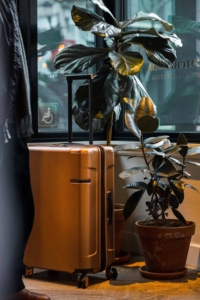
- Medical records and insurance information
- List of allergies and medical conditions
- Medication list with dosage and instructions
- Emergency contact list (family, friends, doctors)
Medications and Medical Supplies:
- A one-week supply of prescription medications (rotate as needed)
- Over-the-counter medications (pain relievers, antacids, etc.)
- Medical equipment (hearing aids, glasses, mobility aids)
- First-aid kit with bandages, antiseptic wipes, and basic medical supplies
Water and Food:
- At least three days’ supply of bottled water (one gallon per person per day)
- Non-perishable, easy-to-open food items (canned goods, granola bars, dry fruits)
- Manual can opener and utensils
Clothing and Bedding:
- Extra clothing, including warm layers
- Sturdy, comfortable shoes and socks
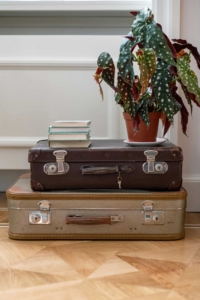
- Blankets or sleeping bags or heat pads/water bottles
Personal Hygiene Items:
- Toothbrush, toothpaste, and dental floss
- Soap, shampoo, and a washcloth
- Sanitary supplies (if applicable)
- Hand sanitizer and wet wipes
Lighting and Communication:
- Flashlight with extra batteries
- Battery-powered or hand-crank emergency radio
- Whistle or signaling device
Personal Comfort and Entertainment:
- Comfort items (favorite books, puzzles, or games)
- Eyeglasses, hearing aids, and spare batteries
- Notepad and pen
Cash and Important Keys: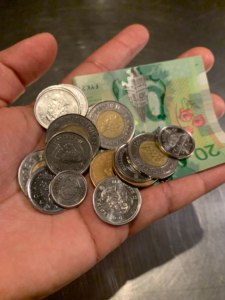
- Small denominations of cash (ATMs may not work during emergencies)
- Spare keys for home and vehicle
EXTRAS to Consider:
- Maps of the local area and an evacuation plan – Meeting places and emergency contact information
- Recent photos of the senior and family members for identification purposes
Pro Tip: Remember to periodically check and refresh the emergency kit to ensure that items are not expired, medications are up-to-date, and documents are current. Store the kit in an easily accessible location, and make sure the senior knows where it is and how to use its contents.
 Conclusion:
Conclusion:
First and foremost, preparedness is key. Seniors, their families, and caregivers must work together to create emergency plans and assemble well-stocked emergency kits tailored to their unique needs that can provide a sense of security during trying times.
Moreover, communication is vital. Seniors should be informed about potential emergencies in their area and be well-versed in evacuation plans, local resources, and emergency contacts. Caregivers and family members should maintain open channels of communication, ensuring that everyone is on the same page and capable of acting swiftly and decisively when the situation calls for it.
Lastly, it is imperative that we as a society foster a culture of inclusion and support for our elderly population. Together, we can help our seniors weather the storm and emerge stronger on the other side.


